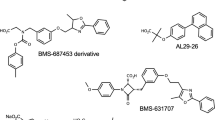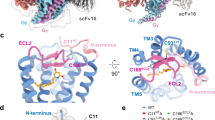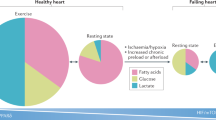Abstract
Peroxisome proliferator activated receptor-γ (PPARγ) regulates metabolic homeostasis and adipocyte differentiation, and it is activated by oxidized and nitrated fatty acids. Here we report the crystal structure of the PPARγ ligand binding domain bound to nitrated linoleic acid, a potent endogenous ligand of PPARγ. Structural and functional studies of receptor-ligand interactions reveal the molecular basis of PPARγ discrimination of various naturally occurring fatty acid derivatives.
This is a preview of subscription content, access via your institution
Access options
Subscribe to this journal
Receive 12 print issues and online access
$189.00 per year
only $15.75 per issue
Buy this article
- Purchase on Springer Link
- Instant access to full article PDF
Prices may be subject to local taxes which are calculated during checkout



Similar content being viewed by others
Accession codes
References
Lehrke, M. & Lazar, M.A. Cell 123, 993–999 (2005).
Forman, B.M. et al. Cell 83, 803–812 (1995).
Kliewer, S.A. et al. Cell 83, 813–819 (1995).
Nagy, L. et al. Cell 93, 229–240 (1998).
Schopfer, F.J. et al. Proc. Natl. Acad. Sci. USA 102, 2340–2345 (2005).
Baker, P.R. et al. J. Biol. Chem. 280, 42464–42475 (2005).
Freeman, B.A. et al. J. Biol. Chem. 283, 15515–15519 (2008).
Evans, R.M., Barish, G.D. & Wang, Y.X. Nat. Med. 10, 355–361 (2004).
Straus, D.S. & Glass, C.K. Trends Immunol. 28, 551–558 (2007).
Yki-Jarvinen, H. N. Engl. J. Med. 351, 1106–1118 (2004).
Nissen, S.E. & Wolski, K. N. Engl. J. Med. 356, 2457–2471 (2007).
Li, Y. et al. Mol. Cell 17, 491–502 (2005).
Gampe, R.T. et al. Mol. Cell 5, 545–555 (2000).
Sarraf, P. et al. Mol. Cell 3, 799–804 (1999).
Tsukahara, T. et al. J. Biol. Chem. 281, 3398–3407 (2006).
Xu, H.E. et al. Mol. Cell 3, 397–403 (1999).
Acknowledgements
We thank W.D. Tolbert and Z. Wawrzak for assistance in data collection at the DND-CAT of the Advanced Photon Source. Use of the Advanced Photon Source was supported by the US Office of Science of the US Department of Energy. This work was supported in part by the Jay and Betty Van Andel Foundation (H.E.X.), US National Institutes of Health Grants DK071662 and DK066202 (H.E.X.), HL089301 (H.E.X. and Y.L.), HL68878, HL089544 and HL75397 (Y.E.C.), HL58115 and HL64937 (B.A.F.), American Diabetes Association (P.R.S.B.) and awards from the American Heart Association (Y.L., F.J.S.).
Author information
Authors and Affiliations
Corresponding authors
Supplementary information
Supplementary Text and Figures
Supplementary Figures 1–3, Supplementary Table 1 and Supplementary Methods (PDF 348 kb)
Rights and permissions
About this article
Cite this article
Li, Y., Zhang, J., Schopfer, F. et al. Molecular recognition of nitrated fatty acids by PPARγ. Nat Struct Mol Biol 15, 865–867 (2008). https://doi.org/10.1038/nsmb.1447
Received:
Accepted:
Published:
Issue Date:
DOI: https://doi.org/10.1038/nsmb.1447
This article is cited by
-
Nitro-fatty acids decrease type I interferons and monocyte chemoattractant protein 1 in ex vivo models of inflammatory arthritis
BMC Immunology (2021)
-
Impacts of lipid-related metabolites, adiposity, and genetic background on blood eosinophil counts: the Nagahama study
Scientific Reports (2021)
-
Structural basis for the inhibitory effects of a novel reversible covalent ligand on PPARγ phosphorylation
Scientific Reports (2019)
-
Electrophilic additions of nitrated fatty acids with biological thiols: comparison with type-2 alkenes
Theoretical Chemistry Accounts (2019)
-
Self-regulation of the inflammatory response by peroxisome proliferator-activated receptors
Inflammation Research (2019)



